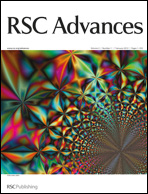Electron detachment dynamics of Cu−(H2O)n (n = 1–3): a direct ab initio MD study†
Abstract
Direct ab initio molecular dynamics (MD) has been applied to the electron detachment dynamics of Cu−(H2O)n (n = 1–3). The initial structures of Cu(H2O)n were generated randomly around the equilibrium point of anionic complex Cu−(H2O)n and then trajectories were run from the vertical electron detachment points of Cu−(H2O)n. It was found that three reaction channels compete with each other when n = 1: dissociation channel (the product is Cu +


 Please wait while we load your content...
Please wait while we load your content...